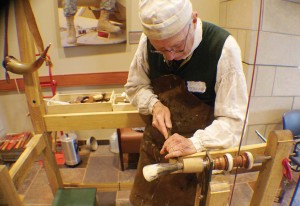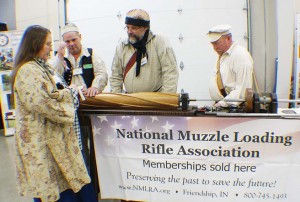by James C. Fulmer | Past President, NMLRA
March, what a month! This month has always been the month for the renewal of muzzleloading shoots and events all across the country. March is a busy month this year, but it wasn’t any busier than it was in 1776, 240 years ago during the American Revolution.
March 2, 1776, in advance of the Continental Army’s occupation of Dorchester Heights during the siege of Boston, General George Washington ordered the artillery forces to start bombarding British positions in the city.

Dick Toone, current guild master of the Honourable Company of Horners, shown working on a spring pole lathe at an annual meeting. This year’s meeting is Mar. 4-5 at the US Army Heritage & Education Center in Carlisle, PA.
During two straight days of bombardment American Brigadier General John Thomas moved 2,000 troops and artillery into position just south of Boston at Dorchester Heights. The new artillery pieces that had been moved into position had been captured in a daring raid at Fort Ticonderoga, NY, by Lieutenant Colonel Benedict Arnold and Ethan Allen with his Green Mountain Boys. General Henry Knox who was the American Commander of the artillery transported the just captured cannons from New York to Boston over the previous winter and placed them in position on Dorchester Heights.
British General Sir William Howe was the commander of the 11,000 British troops who occupied Boston. Howe seeing his position was no longer maintainable decided on March 7, 1776, to evacuate Boston. By March 17 all the ships where loaded with British troops and 1,000 Loyalists. This included 100 civil officials who were moved from Boston to Nantasket Roads five miles south of the city, until March 27 when the fleet sailed for Halifax rather than New York, as the Americans expected. The British were allowed to leave Boston unmolested if they did not burn Boston, but there was a great deal of looting by departing soldiers and loyalists.
General Ward of the American Army entered Boston with 500 troops on March 17. General Washington would follow the next day and the American main army would be in the city on March 20.
The American’s had a pleasant surprise of finding 69 cannons left behind that were still usable, 3,000 blankets, and various supplies left on the wharves. This was due to lack of ships and failure for Howe’s subordinates to follow his orders and destroy all the materials that were left behind.

This historic rifling machine will be demonstrated at 41st Living History Show in Kalamazoo, MI, Mar. 19-20.
The eight-year British Army occupation of Boston came to an end. The eight-month siege had cost the Americans fewer than 200 men killed in action. Boston and Massachusetts were free of British troops for the rest of the war.
For this victory, General Washington, Commander of the Continental Army, was presented with the first medal ever awarded by the Continental Congress.
March is a big month for many new beginnings and start-ups, especially in the muzzleloading sport. Several events take place this time of year. They aren’t all celebrating a 240th anniversary, but the National Muzzle Loading Rifle Association’s Western National Shoot (WNS) is celebrating its 25th Anniversary this year. It is held at the Ben Avery Shooting Facility 25 miles north of Phoenix, AZ, off of I-17.
March 1-7, 2016, muzzleloaders will gather from all over the country to shoot at the WNS. The event hosts an extensive shoot program for all types of muzzleloading rifles, shotguns, and pistols. There is also a large commercial row area where you can purchase all kinds of muzzleloading supplies. This will be a great anniversary event. If you live in the area and love muzzleloaders, this is a must go to event. For more information, go to: www.nmlra.org.
The Honourable Company of Horners 20th Anniversary Meeting will also be this March 4-5, 2016. The muzzleloading shooting sport was growing in leaps and bounds in the 1970s when Roland Cadle noticed a lot of misinformation about powder horns and the historic uses of cow horn. There were a lot of people wanting to know about powder horns and interested in building them, but there was little knowledge on the subject. In March 1996, Roland proposed a seminar on Indian powder horns, early American powder horns, lathe turned horns and their history. It was held at the Mercer Museum in Doylestown, PA, with over 130 people attending. After the weekend meeting, the Honourable Company of Horners (HCH) was founded by 11 fellows who were interested in horn working and its history. One of the primary goals of the HCH is to promote and preserve an active interest in horn working. This year’s annual meeting will be held at the US Army Heritage & Education Center, in Carlisle, PA, and feature a display area with several work stations manned by Master and Journeymen horners making all kind of horn ware. The Guild master, Dick Toone, will be demonstrating the use of a spring pole lathe. There will be an ample amount of horns for sale—both finished products and raw horns, so you can walk out the door with a beautiful new powder product or try your hand at making your own.
The biggest thing I have learned from the HCH annual event is the many products that were made from horn that where replaced by plastic: combs, cups, bowls, containers of all shapes and sizes, lantern panes, frames for glasses, powder horns (of course!) and the list goes on and on.
If you are interested in attending, the HCH is inviting all NMLRA members to attend the conference. Attendance to the conference is by pre-registration $30 for the weekend or $15 a day. Spouses are free. For additional information about the HCH and their event, go to: www.hornguild.org.
There are more events in March then I can list—like I said, it’s a popular month. I need to mention the 41st Annual Kalamazoo Living History Show held March 19-20. The show is held at the Kalamazoo County Fair Grounds, Kalamazoo, MI. It is the largest juried indoor show in the United States devoted to living history and period accouterments. This show has pre-1890 original or reproduction living history supplies, accouterments and related crafts. The event attracts more than 10,000 visitors. There will be over 270 dealers with all the supplies you will need for this year’s upcoming events. I learned if you can’t find it at this event, you probably don’t need it.
During the Kalamazoo show I can be found at the NMLRA booth rifling a barrel on an 18th century style rifling machine. I usually start a new barrel at this show every year and finish at the NMLRA Fort Roberdeau event in Pennsylvania during the month of October. The barrel is rifled across the country for demonstration purposes and, when finished, it will be auctioned off, raffled off or built into a rifle and sold to help pay for NMLRA events. Over the years the rifling machine has made .45 cal., .50 cal., .54 cal., and this year we will be attempting a .62 cal. Jaeger barrel. So stop by if you are in the Kalamazoo area and visit us at the NMLRA booth. For more information about the Kalamazoo Show, go to www.KalamazooShow.com.
My favorite day in March is Saint Patrick’s Day. My favorite Scottish proverb is “They talk about my drinking, but never about my thirst.” Have a great month.



